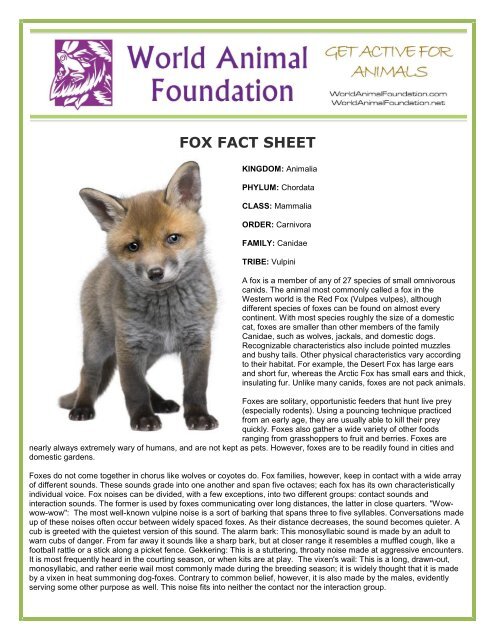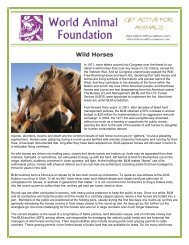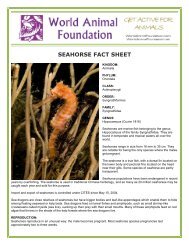FOX FACT SHEET - World Animal Foundation
FOX FACT SHEET - World Animal Foundation
FOX FACT SHEET - World Animal Foundation
Create successful ePaper yourself
Turn your PDF publications into a flip-book with our unique Google optimized e-Paper software.
<strong>FOX</strong> <strong>FACT</strong> <strong>SHEET</strong><br />
KINGDOM: <strong>Animal</strong>ia<br />
PHYLUM: Chordata<br />
CLASS: Mammalia<br />
ORDER: Carnivora<br />
FAMILY: Canidae<br />
TRIBE: Vulpini<br />
A fox is a member of any of 27 species of small omnivorous<br />
canids. The animal most commonly called a fox in the<br />
Western world is the Red Fox (Vulpes vulpes), although<br />
different species of foxes can be found on almost every<br />
continent. With most species roughly the size of a domestic<br />
cat, foxes are smaller than other members of the family<br />
Canidae, such as wolves, jackals, and domestic dogs.<br />
Recognizable characteristics also include pointed muzzles<br />
and bushy tails. Other physical characteristics vary according<br />
to their habitat. For example, the Desert Fox has large ears<br />
and short fur, whereas the Arctic Fox has small ears and thick,<br />
insulating fur. Unlike many canids, foxes are not pack animals.<br />
Foxes are solitary, opportunistic feeders that hunt live prey<br />
(especially rodents). Using a pouncing technique practiced<br />
from an early age, they are usually able to kill their prey<br />
quickly. Foxes also gather a wide variety of other foods<br />
ranging from grasshoppers to fruit and berries. Foxes are<br />
nearly always extremely wary of humans, and are not kept as pets. However, foxes are to be readily found in cities and<br />
domestic gardens.<br />
Foxes do not come together in chorus like wolves or coyotes do. Fox families, however, keep in contact with a wide array<br />
of different sounds. These sounds grade into one another and span five octaves; each fox has its own characteristically<br />
individual voice. Fox noises can be divided, with a few exceptions, into two different groups: contact sounds and<br />
interaction sounds. The former is used by foxes communicating over long distances, the latter in close quarters. "Wowwow-wow":<br />
The most well-known vulpine noise is a sort of barking that spans three to five syllables. Conversations made<br />
up of these noises often occur between widely spaced foxes. As their distance decreases, the sound becomes quieter. A<br />
cub is greeted with the quietest version of this sound. The alarm bark: This monosyllabic sound is made by an adult to<br />
warn cubs of danger. From far away it sounds like a sharp bark, but at closer range it resembles a muffled cough, like a<br />
football rattle or a stick along a picket fence. Gekkering: This is a stuttering, throaty noise made at aggressive encounters.<br />
It is most frequently heard in the courting season, or when kits are at play. The vixen's wail: This is a long, drawn-out,<br />
monosyllabic, and rather eerie wail most commonly made during the breeding season; it is widely thought that it is made<br />
by a vixen in heat summoning dog-foxes. Contrary to common belief, however, it is also made by the males, evidently<br />
serving some other purpose as well. This noise fits into neither the contact nor the interaction group.
ARCTIC <strong>FOX</strong> <strong>FACT</strong> <strong>SHEET</strong><br />
KINGDOM:<br />
<strong>Animal</strong>ia<br />
PHYLUM:<br />
Chordata<br />
CLASS:<br />
Mammalia<br />
ORDER:<br />
Carnivora<br />
FAMILY:<br />
Canidae<br />
GENUS:<br />
Vulpes<br />
SPECIES:<br />
V. lagopus<br />
The Arctic Fox is a small fox native to cold Arctic regions of the Northern Hemisphere. It is common to see an arctic fox in<br />
all three tundra biomes. Artic foxes have smaller, more rounded ears, a more rounded braincase, and a slightly shorter<br />
and broader muzzle than the red fox. The Arctic Fox lives in some of the most frigid extremes on the planet.<br />
Arctic Foxes eat a wide variety of things, including lemmings, Arctic Hare, birds and their eggs and carrion. The most<br />
important of these foods is lemming. A family of foxes can eat dozens of lemmings each day. During April and May, Arctic<br />
Foxes also prey on Ringed Seal pups when the young animals are confined to a snow den and are relatively helpless.<br />
Sometimes they follow polar bears and eat the leftover prey. When their normal prey is scarce, Arctic Foxes scavenge the<br />
leftovers of larger predators, such as Polar Bears, even though Polar Bears' prey includes the Arctic Fox itself.<br />
The foxes tend to form monogamous pairs in the breeding season. Litters of about half a dozen to a dozen whelps are<br />
born in the early summer, a very large litter size for mammals. The parents raise the young in a large den.<br />
Arctic foxes' habitats are tundra and coastal areas. The white morph is generally associated with true tundra habitat, the<br />
blue more with coastal habitat. Arctic Foxes have a circumpolar range, meaning that they are found throughout the entire<br />
Arctic, including Russia, Canada, Nunavut, Alaska, Greenland and Svalbard, as well as in sub-Arctic and alpine areas,<br />
such as Iceland and mainland alpine Scandinavia.<br />
The conservation status of the species is good, except for the Scandinavian mainland population. It is acutely<br />
endangered, despite decades of legal protection from hunting and persecution. The total population estimate in Norway,<br />
Sweden and Finland is a mere 120 adult individuals. The abundance of Arctic Foxes tends to fluctuate in a cycle along<br />
with the population of lemmings. Because the foxes reproduce very quickly and often die young, population levels are not<br />
seriously impacted by the inhumane practice of trapping. They have, nonetheless, been eradicated from many areas<br />
where humans are settled.
FENNEC <strong>FOX</strong> <strong>FACT</strong> <strong>SHEET</strong><br />
KINGDOM:<br />
<strong>Animal</strong>ia<br />
PHYLUM:<br />
Chordata<br />
CLASS:<br />
Mammalia<br />
ORDER:<br />
Carnivora<br />
FAMILY:<br />
Canidae<br />
GENUS:<br />
Vulpes<br />
SPECIES:<br />
V. zerda<br />
The Fennec is a small fox found in the Sahara Desert of North Africa (excluding the coast) which has distinctive oversized<br />
ears. The Fennec is the smallest canid. The animals are often a sandy color to blend in with their desert surroundings. Its<br />
ears, which are the largest in the canid family, serve to help dissipate heat. The coat can repel sunlight during the day and<br />
conserve heat at night. The soles of the feet are protected from the hot sand by thick fur.<br />
The Fennec is nocturnal. During the night, it will hunt for rodents, insects (such as locusts), lizards, and birds and eggs. It<br />
also eats a small lizard known as a sandfish. The Fennec gets most of its water from food, but will sometimes eat berries<br />
and leaves as an additional source of water.<br />
Fennecs live in large dens, often with several foxes. The basic social unit is thought to be a mated pair and their offspring,<br />
and the young of the previous year are believed to remain in the family even after a new litter is born. Playing behavior is<br />
common, including among adults of the species.<br />
They engage in highly social behavior, typically resting while in contact with each other. They mate for life, with each pair<br />
or family controlling their own territory. Sexual maturity is reached at around nine months old. The species usually breeds<br />
only once each year. The copulation tie has been recorded as lasting up to two hours and 45 minutes. Following mating,<br />
the male becomes very aggressive and protective of the female, providing her with food during her pregnancy and<br />
lactation periods. Gestation is usually between 50 to 52 days. The typical litter is between one and four kits, with weaning<br />
taking place at around 61 to 70 days. When born, the kit's ears are folded over and its eyes are closed, with the eyes<br />
opening at around ten days and the ears lifting soon afterwards. The life span of a Fennec Fox has been recorded as up<br />
to 12 years in captivity, but only up to 10 in the wild.<br />
The fennec is rare and is not often seen. It is often hunted by humans, even though the fox does not cause any harm to<br />
human interests.
GRAY <strong>FOX</strong> <strong>FACT</strong> <strong>SHEET</strong><br />
KINGDOM:<br />
<strong>Animal</strong>ia<br />
PHYLUM:<br />
Chordata<br />
CLASS:<br />
Mammalia<br />
ORDER:<br />
Carnivora<br />
FAMILY:<br />
Canidae<br />
GENUS:<br />
Urocyon<br />
SPECIES:<br />
U. cinereoargenteus<br />
The Gray Fox (Urocyon cinereoargenteus) is a species of fox ranging from southern Canada, throughout most of the<br />
lower United States and Central America, to Venezuela. This species, and the closely related Island Fox, are the only<br />
living members of the genus Urocyon, which is considered to be among the most primitive of the living canids. The gray<br />
fox has a gray back, tawny sides, neck and legs, a white belly, and a black stripe along its back and tail. Another black<br />
stripe crosses its face from the nose to the eye and continuing to the side of the head. Standing about 12-16 inches at the<br />
shoulders, weighing up to 16 pounds, and having an overall body length of up to 47 inches, the gray fox is an agile canid<br />
able to scurry up and down trees with relative ease.<br />
The gray fox's ability to climb trees is shared only with the Asian raccoon dog among canids. Its strong, hooked claws<br />
allow it to scramble up trees to escape many predators such as the domestic dog or the coyote, or to reach tree-bound or<br />
arboreal food sources. It descends primarily by jumping from branch to branch, or by descending slowly backwards as a<br />
house cat would do. The gray fox is nocturnal or crepuscular and dens in hollow trees, stumps or appropriated burrows<br />
during the day.<br />
The gray fox is a solitary hunter and is largely omnivorous. It frequently preys upon the Eastern Cottontail, though it will<br />
readily catch voles, shrews, and birds. The gray fox supplements its diet with whatever fruits are readily available and<br />
generally eats more vegetable matter than does the Red Fox.<br />
The gray fox is monogamous. The breeding season of the gray fox varies geographically; in Michigan, the gray fox mates<br />
in early March, in Alabama, breeding peaks occur in February. The gestation period lasts approximately 53 days. Litter<br />
size ranges from 1 to 7. Kits begin to hunt with their parents at the age of 3 months. By the time they are 4 months old, the<br />
kits will have developed their permanent dentition and can now easily forage on their own. The family group still remains<br />
together until autumn when the young reach sexual maturity and then disperse.
RED <strong>FOX</strong> <strong>FACT</strong> <strong>SHEET</strong><br />
KINGDOM: <strong>Animal</strong>ia<br />
PHYLUM: Chordata<br />
CLASS: Mammalia<br />
ORDER: Carnivora<br />
FAMILY: Canidae<br />
TRIBE: Vulpini<br />
GENUS: Vulpes<br />
SPECIES: V. vulpes<br />
The Red Fox (Vulpes vulpes) is the largest of the true foxes, as well as being the most geographically spread member of<br />
the Carnivora, being distributed across the entire northern hemisphere from the Arctic Circle to North Africa, Central<br />
America, and the steppes of Asia. Its range has increased alongside human expansion, having been introduced to<br />
Australia, where it is considered harmful to native mammal and bird populations. Because of these factors, it is listed as<br />
Least Concern for extinction by the IUCN. Forty-five subspecies are currently recognized, which are divided into two<br />
categories: the large northern foxes, and the small, primitive southern foxes of Asia and the Middle East.<br />
Red foxes are social animals, whose groups are led by a mated pair which monopolizes breeding. Subordinates within a<br />
group are typically the young of the mated pair, who remain with their parents to assist in caring for new kits. The species<br />
primarily feeds on small rodents, though it may also target leporids, game birds, reptiles, invertebrates and young<br />
ungulates. Fruit and vegetable matter is also eaten on occasion. Although the red fox tends to displace or even kill its<br />
smaller cousins, it is nonetheless vulnerable to attack from larger predators such as wolves, coyotes, golden jackals and<br />
medium and large felines. The species has a long history of association with humans, having been extensively hunted as<br />
a pest and furbearer for centuries, as well as being prominently represented in human folklore and mythology. Because of<br />
its widespread distribution and large population, the red fox is one of the most important furbearing animals harvested for<br />
the inhumane fur trade.<br />
Red foxes use their urine to mark their territories. Urine is also used to mark empty cache sites, as reminders not to waste<br />
time investigating them. Red foxes live in family group sharing a joint territory or a pack, scout or troop made of an alpha<br />
male and/or female with rogues (loner or abandoned foxes) and family members. In favorable habitats and/or areas with<br />
low hunting pressure, subordinate foxes may be present in a range. Subordinate foxes may number 1-2, sometimes up to<br />
8 in one territory. These subordinates could be formerly dominant animals, but are mostly young from the previous year,<br />
who act as helpers in rearing the breeding vixen's kits. Non-breeding vixens will guard, play, groom, provision and retrieve<br />
kits. Red foxes may leave their families once they reach adulthood if the chances of winning a territory of their own are<br />
high. If not, they will stay with their parents, at the cost of postponing their own reproduction.<br />
Red fox body language consists of movements of the ears, tail and postures, with their body markings emphasizing<br />
certain gestures. Postures can be divided into aggressive/dominant and fearful/submissive categories. Some postures<br />
may blend the two together. Red foxes have a wide vocal range, and produce different sounds spanning five octaves,<br />
which grade into each other.

















